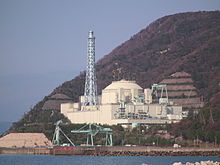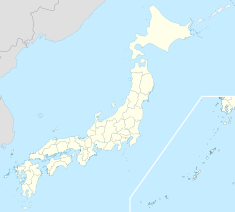- Monju Nuclear Power Plant
-
Monju Nuclear Power Plant
Monju Nuclear Power PlantLocation of the Monju Nuclear Power Plant within Japan Country Japan Location Tsuruga, Fukui Prefecture Coordinates 35°44′25″N 135°59′17″E / 35.74028°N 135.98806°ECoordinates: 35°44′25″N 135°59′17″E / 35.74028°N 135.98806°E Status Operational Construction began May 10, 1986 Commission date August 29, 1995
May 6, 2010 (reactivated)Decommission date December 8, 1995 (suspended for 15 years) Operator(s) Japan Atomic Energy Agency Reactor information Reactors operational 1 x 280 MW Reactor type(s) FBR Power generation information Installed capacity 280 MW As of 14 March 2011 Monju (もんじゅ) is a Japanese sodium-cooled fast reactor, located in Tsuruga, Fukui Prefecture. Construction started in 1986 and the reactor achieved criticality for the first time in April 1994. Its name is a reference to Manjusri.
Monju is a sodium cooled, MOX-fueled, loop-type reactor with three primary coolant loops, producing 280 MWe from 714 MWt.
An accident in December 1995, in which a sodium leak caused a major fire, forced a shutdown. A subsequent scandal involving a cover-up of the scope of the accident delayed its restart until May 6, 2010, with renewed criticality reached on May 8, 2010. In August 2010 another accident, involving dropped machinery, shut down the reactor again. As of June 2011, the reactor has only generated electricity for one hour since its first testing two decades prior.[1]
The plant is located on a site that spans 1.08 km2 (267 acres), the buildings occupy 28,678 m2 (7 acres), and it has 104,680 m2 of floor space. It employs 368 workers.[2]
Contents
Monju sodium leak and fire
On December 8, 1995, the reactor suffered a serious accident. Intense vibration caused a thermowell inside a pipe carrying sodium coolant to break, possibly at a defective weld point, allowing several hundred kilograms of sodium to leak out onto the floor below the pipe. Upon coming into contact with the air, the liquid sodium reacted with oxygen and moisture in the air, filling the room with caustic fumes and producing temperatures of several hundred degrees Celsius. The heat was so intense that it warped several steel structures in the room.[3] An alarm sounded around 7:30 p.m., switching the system over to manual operations, but a full operational shutdown was not ordered until around 9:00 p.m., after the fumes were spotted. When investigators located the source of the spill they found as much as three tons of solidified sodium.
Fortunately, the leak occurred in the plant's secondary cooling system, so the sodium was not radioactive. However, there was massive public outrage in Japan when it was revealed that Power Reactor and Nuclear Fuel Development Corporation (PNC), the semigovernmental agency then in charge of Monju, had tried to cover up the extent of the accident and resulting damage. This coverup included falsifying reports and the editing of a videotape taken immediately after the accident, as well as the issuing of a gag order to employees regarding the existence of the real tapes.
Restart
On November 24, 2000, Japan Atomic Energy Agency announced their intention to restart the Monju reactor. This decision was met with resistance by the public, resulting in a series of court battles. On January 27, 2003, the Nagoya High Court's Kanazawa branch made a ruling reversing its earlier 1983 approval to build the reactor, but then on May 30, 2005, Japan's Supreme Court gave the green light to reopen the Monju reactor.
The restart was scheduled for October 2008, having been moved back five months.[4] A restart date of February 2009 was again delayed due to the discovery of holes in the reactor's auxiliary building; in August 2009 it was announced that restart might be in February 2010.[5]
In February 2010, JAEA obtained official approval to restart the reactor from the Japanese Government. The restart was definitely scheduled for the end of March.[6][dead link] In late February, JAEA requested Fukui Prefecture and Tsuruga City for deliberations aimed at resuming test operation. Having obtained the go-ahead from both entities, JAEA started criticality testing, after which it took some months before commercial operation could resume - as for any new nuclear plant.[7][dead link]
Operators started withdrawing control rods on May 6, 2010, marking the restart of the plant. The Fukui Prefecture governor, Issei Nishikawa asked the METI for additional stimulus to the prefecture including an expansion of the Shinkansen in turn for the restart of the plant. Monju achieved criticality on May 8, at 10:36 AM JST. Test runs were to continue until 2013, at which point the reactor could have started to feed power into the electric grid, being "full fledged" operation.[8][dead link]
In September 2011 the ministry of education, science and technology asked for the fiscal year of 2012 only 20 to 30 percent of the budget to maintain and manage the Monju reactor for the year 2011. The uncertainty about Japan's future energy policy caused the ministry to conclude, that the project could not proceeded. [9]
The testrun of the reactor, in which the reactor's output would be raised to 40 percent of its capacity by the end of March 2012, was postponed on 29 September 2011, by the Japanese Government because the uncertainty over the future of nuclear energy. After the disaster in Fukushima, the Atomic Energy Commission of Japan made a start with a review of Japan's long term energy policy. An outline of this policy would be published within 12 months. On 30 September officials of the Science and Technology ministry explained on meetings in the city of Tsuruga and the prefecture Fukui their decision not to start the test-run. [10]
Possible Decommissioning
On 21 October 2011 the Japanese government installed a commision to study ways to cut wasteful spenditures, one possibility would be decommissioning the Monju prototype fast-breeder reactor. The Government Revitalization Unit took up this issue, because the calls to abolish this reactor were growing after the crises with the nuclear reactors in Fukushima. As the crisis at the Fukushima Daiichi power plant made it difficult, if not impossible, to build new nuclear power plants, the government panel would also review subsidies for localities with atomic power plants as well as functions of related entities such as the Japan Atomic Energy Agency [11]
"In‐Vessel Transfer Machine" falling accident
On August 26, 2010, a 3.3-tonne "In‐Vessel Transfer Machine" fell into the reactor vessel when being removed after a scheduled fuel replacement operation.[12] In October 13, 2010, an unsuccessful attempt was made to retrieve the machine.[13] The JAEA tried to recover the device used in fuel exchange but failed as it had become misshapen, preventing its retrieval through the upper lid.[14][dead link]
The JAEA began preparatory engineering work on May 24, 2011 to set up equipment to be used to retrieve the IVTM that fell inside the vessel[14] The fallen device was successfully retrieved from the reactor vessel on June 23, 2011.[15]
Other FBR programs in Japan
Jōyō is a test fast breeder reactor located in Ōarai, Ibaraki. The reactor was built in the 1970s for the purpose of experimental tests and the development of FBR technologies. The reactor is still in operation today.
The successor to Monju is expected to be a larger demonstration plant that will be completed around 2025, built by the newly formed Mitsubishi FBR Systems company.[16]
See also
- Fast neutron reactor
- Sanshiro Kume
References
- ^ TABUCHI, HIROKO (June 17, 2011). "Japan Strains to Fix a Reactor Damaged Before Quake". The New York Times. http://www.nytimes.com/2011/06/18/world/asia/18japan.html?_r=1&pagewanted=all.
- ^ JAEA (Japanese). Facilities Quick View.
- ^ POLLACK, ANDREW (February 24, 1996). "REACTOR ACCIDENT IN JAPAN IMPERILS ENERGY PROGRAM". New York Times: p. A.1.
- ^ World Nuclear News. Monju enters extended testing. Aug 31, 2007.
- ^ Reuters. Japan fast-breeder reactor may restart in Feb. Aug 12, 2009.
- ^ The Yomiuri Online. Monju reactor clears hurdle to restart.[dead link] Feb 23, 2010.
- ^ The Denki Shinbun. First step toward resuming test operation of Monju.[dead link] Feb 26, 2010.
- ^ Mari Yamaguchi. The Associated Press. Japan reactor reopens after 1995 accident.[dead link] May 6, 2010.
- ^ JAIF (26 September 2011) Earth-quake-report 217 :Japan to freeze fast-breeder reactor project
- ^ JAIF(29 september 2011)Earthuake-report 219: Japan to postpone test to restart Monju reactor
- ^ Mainichi Japan (22 October 2011) Gov't cost-cutting unit to study Monju reactor's abolition
- ^ "高速増殖原型炉もんじゅ燃料交換片付け作業中における炉内中継装置の落下について(中間報告)" (in Japanese). Turuga Head Office, JAEA. 1 October 2010. http://www.jaea.go.jp/04/turuga/jturuga/press/2010/10/p101001-2.pdf. Retrieved 14 March 2011.
- ^ もんじゅ、装置回収また中断 ふたに引っ掛かる?. October 14, 2010.
- ^ a b The Mainichi Daily News. Agency gears up to retrieve device fallen inside Monju reactor.[dead link] May 24, 2011.
- ^ Fallen device retrieved from Japan fast-breeder reactor June 23, 2011.
- ^ "New fast breeder reactor for Japan". Nuclear Engineering International. 6 June 2006. http://www.neimagazine.com/story.asp?storyCode=2036584. Retrieved 16 March 2011.
External links
- Video explaining the Monju accident[dead link] (Japanese)
- Monju home page
- Leaked video of the 1995 accident, with subtitles in 5 languages
Nuclear power in Japan Active LWR plants Other plants Kaminoseki · Maki · Monju · Namie-Odaka · Ōma · Fugen (ATR) (inactive) · Jōyō (FBR) · Rokkasho (reprocessing)Fukushima Daiichi nuclear disaster Cleanup · Timeline · Radiation effects · Japanese reaction · International reaction · Reactor units 4, 5 and 6Companies Chugoku Electric Power Company · Japan Nuclear Fuel Limited · Mitsubishi FBR Systems · Tokyo Electric Power CompanyOrganisations Atomic Energy Commission · Japan Atomic Energy Agency · Japan Electric Association · Nuclear Safety Commission · Nuclear and Industrial Safety AgencyAnti-nuclear movement Anti-nuclear protests · Citizen's Nuclear Information Center · Tetsunari Iida · Haruki Murakami · Kenzaburo Oe · Ryuichi SakamotoMiscellaneous 2011 Japanese nuclear accidents · Iwaishima · Japanese nuclear incidents · Radiation Monitoring · Genpatsu-shinsaiNuclear technology Science Fuel Deuterium · Fertile material · Fissile · Isotope separation · Plutonium · Thorium · Tritium · Uranium (enriched • depleted)Neutron Activation · Capture · Cross-section · Fast · Fusion · Generator · Poison · Radiation · Reflector · Temp · ThermalReactors Boiling (BWR · ABWR) · Heavy (CANDU · PHWR · SGHWR) · Natural (NFR) · Pressurized (PWR · VVER · EPR) · Supercritical (SCWR)Advanced gas-cooled (AGR) · Magnox · Pebble bed (PBMR) · RBMK · UHTREX · Very high temperature (VHTR)FLiBeNone
(Fast)Breeder (FBR) · Integral (IFR) · Liquid-metal-cooled (LMFR) · SSTAR · Traveling Wave (TWR)
Generation IV by coolant: (Gas (GFR) · Lead (LFR) · Sodium (SFR))OtherPower Medicine TherapyWeapon TopicsListsWaste ProductsActinide: (Reprocessed uranium · Reactor-grade plutonium · Minor actinide) · Activation · Fission (LLFP)DisposalDebate Nuclear power debate · Nuclear weapons debate · Anti-nuclear movement · Uranium mining debate · Nuclear power phase-outCategories:- 1980s establishments in Japan
- Civilian nuclear power accidents
- Liquid metal fast reactors
- Nuclear power stations in Japan
Wikimedia Foundation. 2010.


